Purpose and selection criteria for large pots
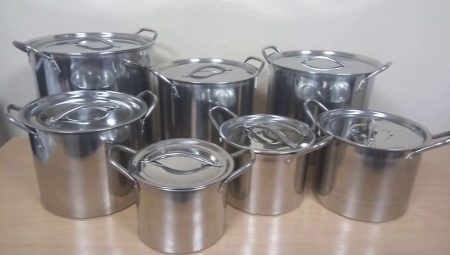
In many families, the largest pot is considered to be an inventory of 5 liters. However, such a saucepan is by no means large, but medium, large containers include vessels with a volume of 10 liters or more. These huge pots, more like tanks, can be made of different materials and offered in several varieties. Perhaps, in a home kitchen, such a unit is not so convenient to use, but in catering establishments one cannot do without large pans.
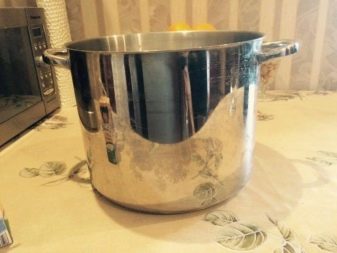
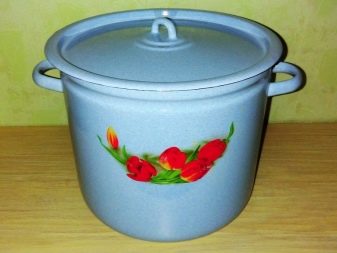
Peculiarities
A 10-liter saucepan is a suitable option for a family in which preparations are often made, jellied meat is cooked, compotes and fruit drinks are prepared. If the pan is chosen for preparing the first courses, then keep in mind that the standard portion of the soup is 250-300 grams, in addition, the first courses during cooking require frequent stirring and therefore require another 2-3 liters of additional volume.
When choosing a material, it is important to give preference to thick-walled options.... Large-capacity pots must be of good quality, otherwise the food will be unevenly processed, and may even burn altogether. In catering establishments, a large saucepan allows you to cook a large amount of food at a time. A spacious container provides convenient preparation of products, which increase in volume during cooking, since high walls prevent them from sticking out of the container.
Of the disadvantages of a large product, it is worth noting the fact that food burns in them more often, so it is recommended to choose specimens with a capsule bottom.
The larger the diameter of the pan, the higher its walls, the more difficult it is to work with it. To do this, you need to have some auxiliary elements, for example, a ladle with a long handle.When washing such large containers, problems also arise.
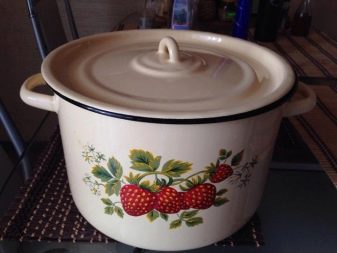
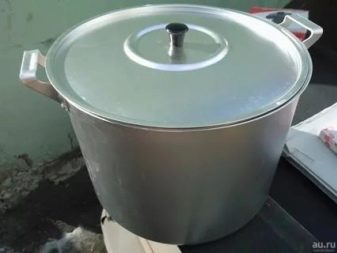
Varieties
There are the following types of large pots.
10 liters. This option is suitable for home use. Due to its relatively small volume, this is not a heavy pan that one housewife can handle on her own. In a family, such a unit can be used, for example, when preparing compote or in order to boil water for washing or for the period when hot water is turned off.
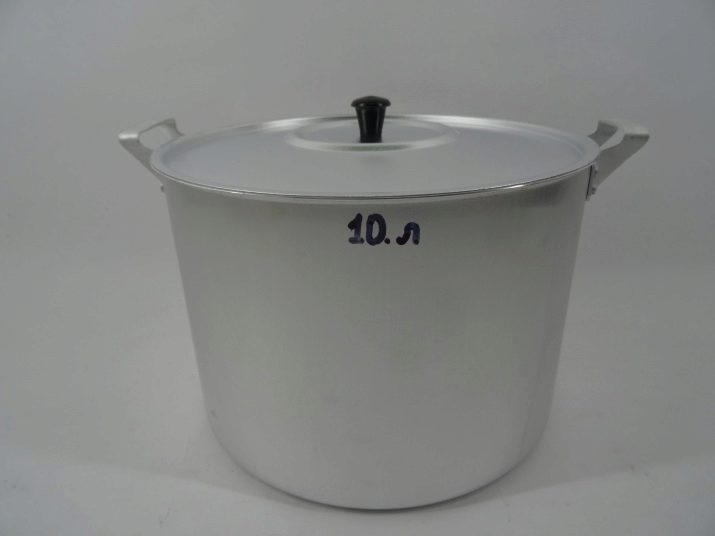
15 liters... In appearance, these specimens do not differ much from the previous version, they can be used both at home and in the dining room.
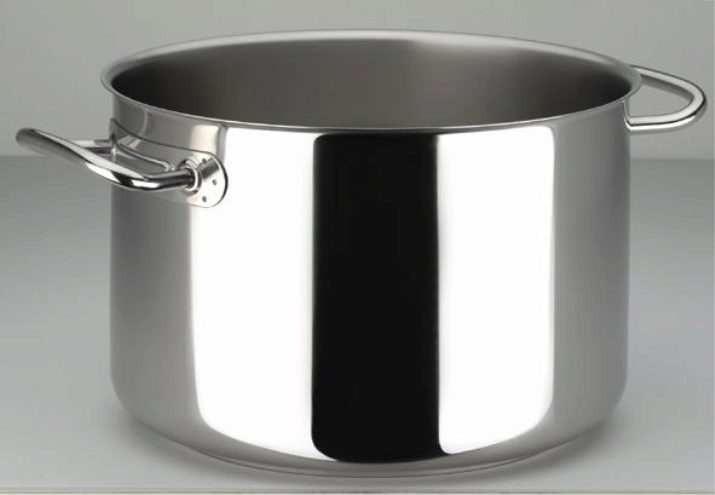
- 20 liters. These products are mainly used for boiling water and preparing second courses in schools, kindergartens, and children's canteens.
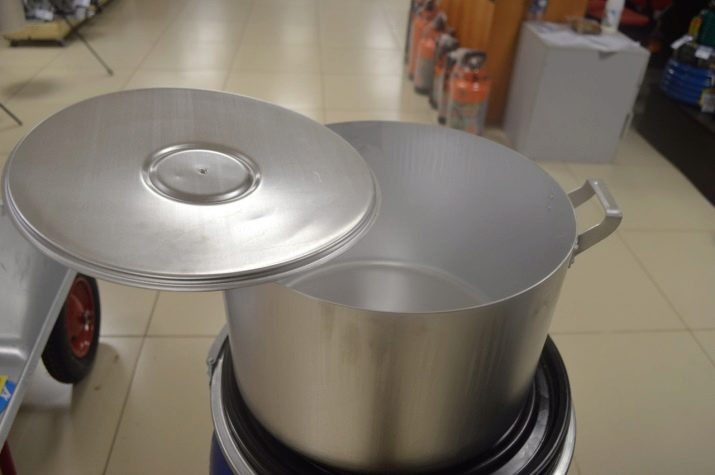
- 50-70 liters. These copies are for public use only. These utensils are purchased in batches from cafes, restaurants, canteens.
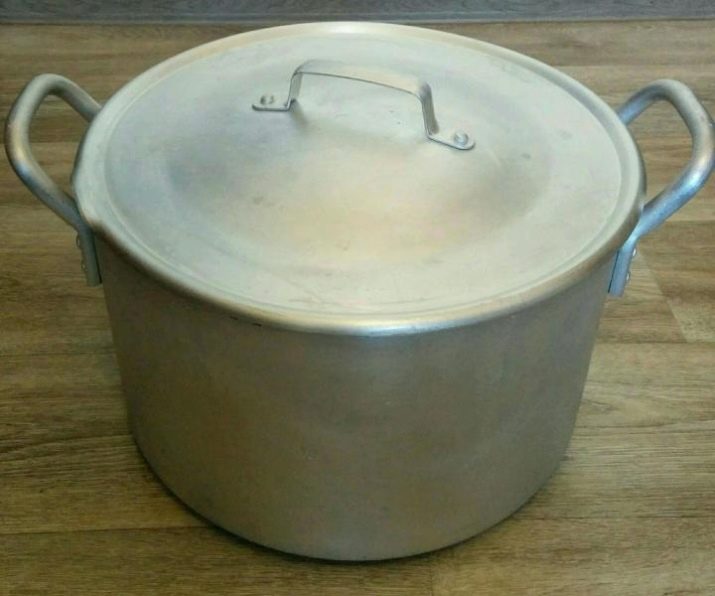
Manufacturing material
Large pots can be made from a variety of materials.
Aluminum
They attract with their democratic price, but in terms of quality they are inferior to other options. If you boil porridge or pasta in them, then the dish may burn, and it is better not to cook liquid food like soup or fruit drink in such a product, since aluminum, in contact with acid, releases harmful substances. These products quickly deform and bend, are difficult to maintain, but are lightweight. If the choice fell on an aluminum pan, then it is better to choose a copy of no more than 15 liters, so that it is easier to mix the boiled products and avoid burning.
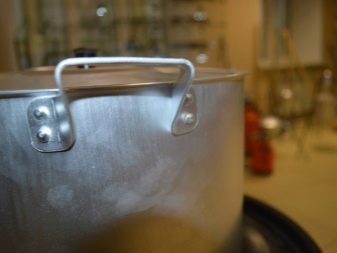
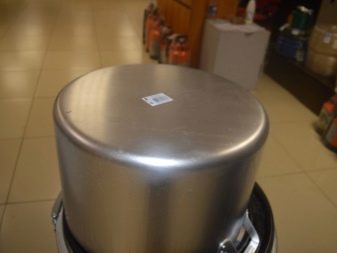
Stainless steel
The most popular option both in home and public kitchens. The most preferred option is labeled 18/10. The main advantage of such dishes is the ability to cook with a minimum amount of oil. Internal moisture prevents food from burning.
Large stainless steel containers are often used in sanatorium or hospital kitchens. If possible, it is better to give preference to models with a double capsule bottom, so that the bottom and sides warm up faster. Instances made of stainless steel are easy to maintain, hygienic and have a long service life. It is recommended to wash them. ordinary soda solution. Another advantage of such dishes is the ability to store any products in it, the material has bacteriostatic properties that preserve the freshness of the contents for a long time.
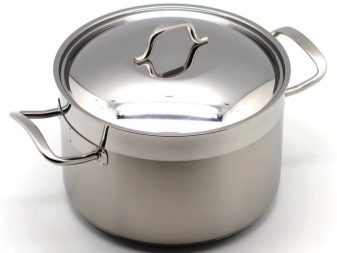
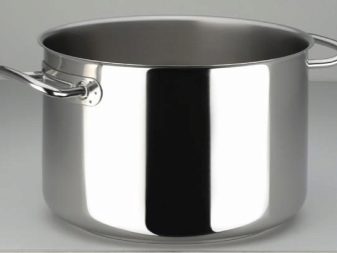
Enameled
Also a fairly common option. It has a low cost, light weight and interesting design. However, these items are quite fragile. If this is a very large pot, then it is more difficult to handle it, it is more likely during operation to accidentally hit it against the wall or bottom of the sink. That's why chips and cracks quickly form on the surface, and such a deformed pan can no longer be used.
Another disadvantage of enameled varieties is the frequent burning of food, especially for models with a thin bottom. In addition, before the first use, such a pan must be processed using a special technology: pour water to the brim, add salt in a proportion of 2 tbsp. l. per liter of water, bring to a boil and wait until it cools completely.
Other materials are known from which pots are made: ceramics, cast iron, glass, however, these options are often not designed for the production of large-volume products, since, for example, a cast-iron pot will be simply too heavy.
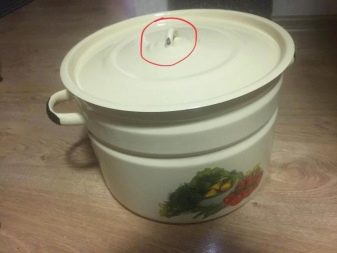
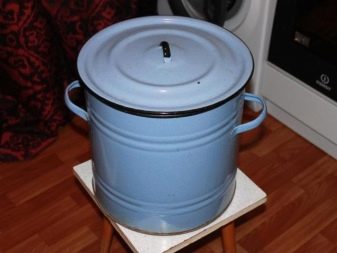
How to choose?
Consider the following factors before choosing a pot size:
- The 10-liter version is suitable for a large family or a public dining room; about 25 people can be fed from it;
- a 20 liter product is the best option for a public kitchen that serves up to 50 people daily;
- an instance with a volume of 30-40 liters is intended for a small dining room or sanatorium kitchen;
- the massive 60-liter version is only suitable where a large number of people are constantly served.
If a large saucepan is chosen for a home kitchen, then the features of the stove should also be taken into account. So, it is easiest to choose a vessel for a gas unit, since the intensity of the flame in this case can be controlled, which means that the size of the bottom is not so important.
But, as already mentioned, the most capacious option for a home should be limited to 15 liters, it is more difficult to work with other specimens, there is practically no need for them.

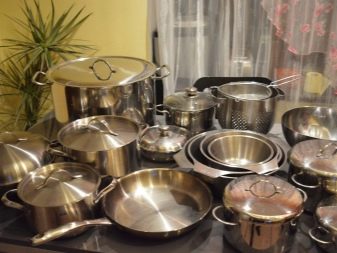
If an old-style electric stove is used in the kitchen, it is important to select pots with a bottom diameter smaller than the circumference of the burner, however, there are practically no such pans among large pots. In addition, most electric stoves cannot boast of high power, which means that they will heat the contents of a large pan for a very long time. Therefore, an electric stove is not the most suitable option for cooking food in a bulk container.
In the case of glass-ceramic hobs, it is possible to adjust the heating process for pots of different sizes. Remember that the wide-bottomed, low-sided version will cook faster than the narrow but tall item. Read on for a few more tips when choosing a large pot.
- If you need a container for preparing first courses, then choose an instance with high walls.
- For porridge or other main courses, give preference to models with a wide bottom. Then it will be easier to stir the dish, and the likelihood of burning will be minimal.
- Choose a set of pots from trusted manufacturers. So, according to customer reviews, the most high-quality large-volume products are made by Gipfel, Luxstahl, Zepter, Fissman.

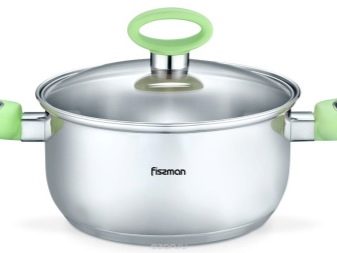
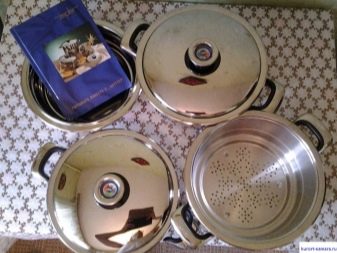
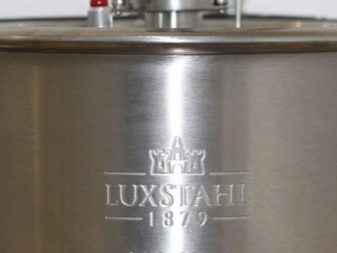
See below for how to choose the right saucepan.








